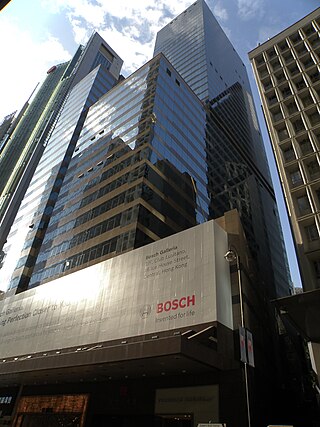
New World Development Company Limited (NWD), is a Hong Kong–based company focused on property, hotels, infrastructure and services and department stores. It was established on 29 May 1970 by Cheng Yu-tung. The company is publicly listed on the Stock Exchange of Hong Kong Limited since 23 November 1972 and was formerly a constituent stock of Hong Kong Hang Seng Index.

SAIC Motor Corp., Ltd. is a Chinese state-owned automobile manufacturer headquartered in Anting, Shanghai. Founded in 1955, it is currently the largest of the "Big Four" state-owned car manufacturers of China ahead of FAW Group, Dongfeng Motor Corporation, and Changan Automobile, with sales of 5.02 million vehicles in 2023.

TCL Technology Group Corp. is a Chinese partially state-owned electronics company headquartered in Huizhou, Guangdong province. TCL develops, manufactures, and sells consumer electronics like television sets, mobile phones, air conditioners, washing machines, refrigerators, and small electrical appliances. In 2010, it was the world's 25th-largest consumer electronics producer. On 7 February 2020, TCL Corporation changed its name to TCL Technology. It was the second-largest television manufacturer by market share in 2022 and 2023.
BYD Auto Co., Ltd. is the main automotive subsidiary and brand of BYD Company, a publicly listed Chinese multinational manufacturing company. It manufactures passenger battery electric vehicles (BEVs) and plug-in hybrid electric vehicles (PHEVs), collectively known as new energy vehicles (NEVs) in China. It also produces electric buses and trucks. The company sells its vehicles under the main BYD brand and high-end vehicles under its Denza, Yangwang and Fangchengbao brands.

Dunlop Tyres is a brand of tyres which is managed by different companies around the world. It was founded by pneumatic tyre pioneer John Boyd Dunlop in Belfast, Ireland, in 1888.

Xiaolan is a town situated at the northwest periphery of the city of Zhongshan, Guangdong Province, China.

Pfäfers is a municipality in the Wahlkreis (constituency) of Sarganserland in the canton of St. Gallen in Switzerland. The villages Pfäfers, St. Margrethenberg, Vadura, Valens, Vasön and Vättis belong to the municipality.

Koala's March is a bite-sized cookie snack with a sweet filling. The cookies are produced by Lotte.
Hon Hai Precision Industry Co., Ltd. (鴻海精密工業股份有限公司), doing business as Hon Hai Technology Group (鴻海科技集團) in Taiwan, Foxconn Technology Group (富士康科技集团) in Mainland China, and Foxconn (富士康) internationally, is a Taiwanese multinational electronics contract manufacturer established in 1974 with headquarters in Tucheng District, New Taipei City, Taiwan. In 2023, the company's annual revenue reached 6.16 trillion New Taiwan dollars and was ranked 20th in the 2023 Fortune Global 500. It is the world's largest contract manufacturer of electronics. While headquartered in Taiwan, the company earns the majority of its revenue from assets in China and is one of the largest employers worldwide. Terry Gou is the company founder and former chairman.

Vätti is a district of the city of Turku, in Finland. It is located to the north of the city centre. The area consists mostly of parkland, but there is also a high-density residential area in the district as well as some low-density developments. There is also an old people's home in Vätti.

AGA Rangemaster is a British manufacturer of range cookers, kitchen appliances, and interior furnishings owned by Middleby Corporation in September 2015 after it received a takeover approach from Whirlpool. It employs just over 2,500 people worldwide. AGA stands for Aktiebolaget Gas Accumulator.
Ispiritista: Itay, May Moomoo! is a 2005 Filipino comedy horror fantasy film directed by Tony Y. Reyes, based on a story concept by Reyes, Antonio P. Tuviera, and Nino Tuviera-Rodriguez, with a screenplay by Reyes and R.J. Nuevas, and starring Vic Sotto, Cindy Kurleto, Iza Calzado and BJ Forbes.
Moo moo or variation, may refer to:
Azul Linhas Aéreas Brasileiras S/A is a Brazilian airline headquartered in Barueri, a suburb of São Paulo. The company's business model is to stimulate demand by providing frequent and affordable air service to underserved markets throughout Brazil. The company was named Azul after a naming contest in 2008, where "Samba" was the other popular name. Azul is a publicly traded company on the Brazilian stock exchange, with the ticker AZUL4. It was established on 5 May 2008 by Brazilian-born David Neeleman, with a fleet of 76 Embraer 195 jets. The airline began service on 15 December 2008.

BYD Company Limited or BYD is a publicly listed Chinese multinational manufacturing conglomerate headquartered in Shenzhen, Guangdong, China. It is a vertically integrated company with several major subsidiaries, including BYD Auto which produces automobiles, BYD Electronics which produces electronic parts and assembly, and FinDreams, a brand name of multiple companies that produces automotive components and electric vehicle batteries.
Futu Holdings Limited ("Futu") is a financial technology company offering digital financial services across global markets. Futu and its subsidiaries operate in seven key regions, including Hong Kong, the United States, Singapore, Australia, Japan, Canada, Malaysia. It provides a range of investment services and holds over 100 licenses and qualifications across various jurisdictions. Futu also owns Futu Securities International Limited, which is a licensed corporation recognized by the Hong Kong Securities and Futures Commission.
Sürengiin Möömöö was a Mongolian linguist and chess player. He was born in 1930 in Khyargas, Uvs, and died on 7 July 2021 due to illness.
Liaoning Fangda Group Industrial Company Ltd is a Chinese industrial conglomerate focusing on carbon, chemicals, medical, steel products manufacturing, real estate development, mining, coking, aviation and other services.

Moomoo is a global investment and trading platform. Founded in 2018, Moomoo has expanded its operations to Singapore, Australia, Japan, Canada, and Malaysia. Alongside its sister brand, Futubull in Hong Kong, Moomoo serves a user base of over 24.1 million individuals.











